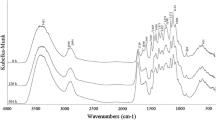Summaries
Wood exposed to the outdoors undergoes photo-oxidative degradation in a natural weathering process.
The efficacy of various treatments for the protection of wood surfaces from weathering elements (ultraviolet radiation and water) was investigated by using the measurements of the changes in adhesion on fir and oak samples after their exposure to natural climatic conditions and after accelerated weathering.
The most efficacious of the six UV-protective treatments proved to be the treatment of the wood surfaces with a semi-transparent stain, followed by treatments with a transparent wood stain containing two types of photostabilisers. The stabilisation of the wood surfaces by ferric nitrate did not improve the performance of the wood stain used.
Résumé
Le bois qui est exposé aux intempéries subit une dégradation photooxidative dans le cadre d’un processus de dégradation naturelle.
L’efficacité de différents traitements pour la protection des surfaces de bois contre les éléments de dégradation (rayons ultraviolets et eau) est investiguée en effectuant des mesures des changements de l’adhésion sur des échantillons de chêne et de sapin après leur exposition aux intempéries naturelles et après avoir subi un processus de dégradation accélérée.
Il est noté que le plus efficace des six traitements protecteur contre les rayons UV s’avère d’être le traitement des surfaces de bois par une teinture demi-transparente suivi d’une teinture de bois transparente contenant deux genres de photostabilisants. La stabilisation de la surface des bois par le moyen de l’utilisation du nitrate ferrique n’améliore pas la performance de la teinture de bois utilisée.
Zusammenfassung
Holz, das der Witterung ausgesetzt ist, degeneriert normalerweise durch den Einfluß von UV-Licht und Wasser.
Wir untersuchten die Leistung verschiedener Schutzanstriche mittels Proben von Fichte und Eiche, die mit Schutzlacken beschichtet natürlichen und beschleunigten Witterungseinflüssen ausgesetzt wurden. Die Haftkraft der Schutzanstriche wurde während und nach den Tests bewertet.
Der beste der sechs Schutzanstriche in unserem Test war eine semi-transparente Lasur, gefolgt von einer transparenten Lasur die zwei verschiedene Fotostabilisatoren enthielt. Die Stabilisierung der Holzoberfläche mit Eiseenitrat verbesserte die Leistung der Lasur nicht.
Similar content being viewed by others
References
Hon D N-S, ‘Photochemical degradation of lignocellulosic materials’,Developments in Polymer Degradation, (ed) N Grassie, (3rd edition), Chapter 8, 229–81, Applied Science Publishers, Barking and London, 1981
Feist W C, D N-S Hon ‘Chemistry of weathering and protection’,The Chemistry of Solid Wood: Advances in Chemistry Series 207, (ed) R Rowell, Chapter 11, 401–55; Proceedings of 185th meeting of the American Chemical Society, 20th to 25th March 1983, Seattle, Washington DC, American Chemical Society, Washington, 1984
Horn B A, J Qiu, N L Owen and W C Feist ‘FT-IR studies of weathering effects in western red cedar and southern pine: Chemical modification of lignocellulosics’,FRI Bulletin,176, 67–76, New Zealand Forest Research Institute, Rotorua, New Zealand, 1992
Chang S-T, N-S Hon and W C Feist ‘Photodegradation and photoprotection of wood surfaces”,Wood and Fibre,14, (2), 104–17, 1982
Hon D N-S, S T Chang and W C Feist ‘Protection of wood surfaces against photodegradation’,J Appl Polym Sci,30, 1429–48, 1985
Böhnke H and E Hess ‘Lichtschutzmittel in lacken:möglichkeiten und grenzen’,Farbe und Lack,95, (10), 715–9, 1989
Derbyshire H and E R Miller, ‘The photodegradation of wood during irradiation. Part 1: effects on structural integrity of thin wood strips’,Holz als Roh-und Werkstoff,39, 341–50, 1981
Black J M and E A Mraz ‘Outdoor wood weathering and protection’, Research Paper FPL 232, US Department of Agriculture, Forest Service, Forest Products Laboratory, Madison, WI, 1974
Feist W C, ‘Wood surface treatments to prevent extractive staining of paints’,Forest Prod J,27, (5), 50–4, 1977
Feist W C and W D Ellis, “Fixation of hexavalent chromium on wood surfaces’,Wood Science,11, (2), 76–81, 1978
Feist W C, ‘Protection of wood surfaces with chromium trioxide’, Research Paper FPL 339, US Department of Agriculture, Forest Service, Forest Products Laboratory, Madison, WI, 1979
Feist W C, ‘Weathering performance of finished yellow-poplar siding’,Forest Prod J,37, (3), 15–22, 1987
Williams R S, ‘Effect of grafted UV stabilisers on wood surface erosion and clear coating performance’,J Appl Polym Sci,28, 2093–103, 1983
Author information
Authors and Affiliations
Corresponding author
Rights and permissions
About this article
Cite this article
Jirous-Rajkovic, V., Bogner, A. & Radovan, D. The efficiency of various treatments in protecting wood surfaces against weathering. Surface Coatings International Part B: Coatings Transactions 87, 15–19 (2004). https://doi.org/10.1007/BF02699559
Issue Date:
DOI: https://doi.org/10.1007/BF02699559




